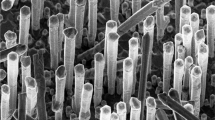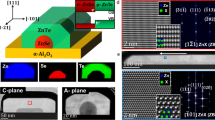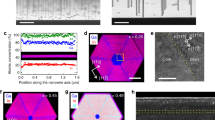Abstract
Semiconductor nanowires are potential candidates for applications in quantum information processing1,2, Josephson junctions3,4 and field-effect transistors5,6,7,8 and provide a unique test bed for low-dimensional physical phenomena9. The ability to fabricate nanowire heterostructures with atomically flat, defect-free interfaces enables energy band engineering in both axial10,11,12 and radial13,14,15,16 directions. The design of radial, or core–shell, nanowire heterostructures relies on energy band offsets that confine charge carriers into the core region, potentially reducing scattering from charged impurities on the nanowire surface13,14,15,16. Key to the design of such nanoscale heterostructures is a fundamental understanding of the heterointerface properties, particularly energy band offsets and strain. The charge-transfer and confinement mechanism can be used to achieve modulation doping17,18,19 in core–shell structures20,21. By selectively doping the shell, which has a larger bandgap, charge carriers are donated and confined in the core, generating a quasi-one-dimensional electron system with higher mobility. Here, we demonstrate radial modulation doping in coherently strained Ge–SixGe1−x core–shell nanowires and a technique to directly measure their valence band offset. Radial modulation doping is achieved by incorporating a B-doped layer during epitaxial shell growth. In contrast to previous work showing site-selective doping in Ge–Si core–shell nanowires13,22, we find both an enhancement in peak hole mobility compared with undoped nanowires and observe a decoupling of electron transport in the core and shell regions. This decoupling stems from the higher carrier mobility in the core than in the shell and allows a direct measurement of the valence band offset for nanowires of various shell compositions.
This is a preview of subscription content, access via your institution
Access options
Subscribe to this journal
Receive 12 print issues and online access
$259.00 per year
only $21.58 per issue
Buy this article
- Purchase on Springer Link
- Instant access to full article PDF
Prices may be subject to local taxes which are calculated during checkout




Similar content being viewed by others

References
Hu, Y. et al. A Ge/Si heterostructure nanowire-based double quantum dot with integrated charge sensor. Nature Nanotech. 2, 622–625 (2007).
Nadj-Perge, S., Frolov, S. M., Bakkers, E. P. A. M. & Kouwenhoven, L. P. Spin–orbit qubit in a semiconductor nanowire. Nature 468, 1084–1087 (2010).
Xiang, J., Vidan, A., Tinkham, M., Westervelt, R. M. & Lieber, C. M. Ge/Si nanowire mesoscopic Josephson junctions. Nature Nanotech. 1, 208–213 (2006).
Nilsson, H. A., Samuelsson, P., Caroff, P. & Xu, H. Q. Supercurrent and multiple Andreev reflections in an InSb nanowire Josephson junction. Nano Lett. 12, 228–233 (2012).
Auth, C. P. & Plummer, J. D. Scaling theory for cylindrical, fully-depleted, surrounding-gate MOSFETs. IEEE Electron. Dev. Lett. 18, 74–76 (1997).
Wang, D. et al. Germanium nanowire field-effect transistors with SiO2 and high-κ HfO2 gate dielectrics. Appl. Phys. Lett. 83, 2432–2434 (2003).
Bryllert, T., Wernersson, L-E., Froberg, L. E. & Samuelson, L. Vertical high-mobility wrap-gated InAs nanowire transistor. IEEE Electron. Dev. Lett. 27, 323–325 (2006).
Xiang, J. et al. Ge/Si nanowire heterostructures as high-performance field-effect transistors. Nature 441, 489–493 (2006).
Kloeffel, C., Trif, M. & Loss, D. Strong spin–orbit interaction and helical hole states in Ge/Si nanowires. Phys. Rev. B 84, 195314 (2011).
Wu, Y., Fan, R. & Yang, P. Block-by-block growth of single-crystalline Si/SiGe superlattice nanowires. Nano Lett. 2, 83–86 (2002).
Björk, M. T. et al. Few-electron quantum dots in nanowires. Nano Lett. 4, 1621–1625 (2004).
Fuhrer, A. et al. Few electron double quantum dots in InAs/InP nanowire heterostructures. Nano Lett. 7, 243–246 (2007).
Lauhon, L. J., Gudiksen, M. S., Wang, D. & Lieber, C. M. Epitaxial core–shell and core–multishell nanowire heterostructures. Nature 420, 57–61 (2002).
Lu, W., Xiang, J., Timko, B. P., Wu, Y. & Lieber, C. M. One-dimensional hole gas in germanium/silicon nanowire heterostructures. Proc. Natl Acad. Sci. USA 102, 10046–10051 (2005).
Jiang, X. et al. InAs/InP radial nanowire heterostructures as high electron mobility devices. Nano Lett. 7, 3214–3218 (2007).
Nah, J., Dillen, D. C., Varahramyan, K. M., Banerjee, S. K. & Tutuc, E. Role of confinement on carrier transport in Ge–SiGe core–shell nanowires. Nano Lett. 12, 108–112 (2011).
Dingle, R., Störmer, H. L., Gossard, A. C. & Wiegmann, W. Electron mobilities in modulation-doped semiconductor heterojunction superlattices. Appl. Phys. Lett. 33, 665–667 (1978).
People, R. et al. Modulation doping in GeSi/Si strained layer heterostructures. Appl. Phys. Lett. 45, 1231–1233 (1984).
Abstreiter, G., Brugger, H., Wolf, T., Jorke, H. & Herzog, H. J. Strain-induced two-dimensional electron gas in selectively doped Si/SiGe superlattices. Phys. Rev. Lett. 54, 2441–2444 (1985).
Lee, H. & Choi, H. J. Single-impurity scattering and carrier mobility in doped Ge/Si core–shell nanowires. Nano Lett. 10, 2207–2210 (2010).
Amato, M., Ossicini, S. & Rurali, R. Band-offset driven efficiency of the doping of SiGe core–shell nanowires. Nano Lett. 11, 594–598 (2011).
Fukata, N. et al. Characterization of impurity doping and stress in Si/Ge and Ge/Si core–shell nanowires. ACS Nano 6, 8887–8895 (2012).
Varahramyan, K. M., Ferrer, D., Tutuc, E. & Banerjee, S. K. Band engineered epitaxial Ge–SiGe core–shell nanowire heterostructures. Appl. Phys. Lett. 95, 033101 (2009).
Menéndez, J., Singh, R. & Drucker, J. Theory of strain effects on the Raman spectrum of Si–Ge core–shell nanowires. Ann. Phys. (Leipz.) 523, 145–156 (2011).
Dillen, D. C., Varahramyan, K. M., Corbet, C. M. & Tutuc, E. Raman spectroscopy and strain mapping in individual Ge–SiGe core–shell nanowires. Phys. Rev. B 86, 045311 (2012).
Nah, J., Varahramyan, K., Liu, E-S., Banerjee, S. K. & Tutuc, E. Doping of Ge–SiGe core–shell nanowires using low energy ion implantation. Appl. Phys. Lett. 93, 203108 (2008).
Schäffler, F. High-mobility Si and Ge structures. Semicond. Sci. Technol. 12, 1515–1549 (1997).
Morar, J. F., Batson, P. E. & Tersoff, J. Heterojunction band lineups in Si–Ge alloys using spatially resolved electron-energy-loss spectroscopy. Phys. Rev. B 47, 4107–4110 (1993).
Rieger, M. M. & Vogl, P. Electronic-band parameters in strained SiGe alloys on SiGe substrates. Phys. Rev. B 48, 14276–14287 (1993).
Liang, Y., Nix, W. D., Griffin, P. B. & Plummer, J. D. Critical thickness enhancement of epitaxial SiGe films grown on small structures. J. Appl. Phys. 97, 043519 (2005).
Schmidt, V., McIntyre, P. C. & Gösele, U. Morphological instability of misfit-strained core–shell nanowires. Phys. Rev. B 77, 235302 (2008).
Grönqvist, J. et al. Strain in semiconductor core–shell nanowires. J. Appl. Phys. 106, 053508 (2009).
Bai, W. P., Lu, N. & Kwong, D-L. Si interlayer passivation on germanium MOS capacitors with high-κ dielectric and metal gate. IEEE Electron. Dev. Lett. 26, 378–380 (2005).
Acknowledgements
This work was supported by the National Science Foundation (grants DMR-0846573 and DMR-0819860) and by the Norman Hackerman Advanced Research Program. The authors thank K. Varahramyan for technical discussions and assistance.
Author information
Authors and Affiliations
Contributions
D.C.D. performed nanowire sample growth, nanowire device fabrication and characterization, with assistance from K.K. and E-S.L. D.C.D. and E.T. analysed the data and wrote the paper, with input from all authors.
Corresponding author
Ethics declarations
Competing interests
The authors declare no competing financial interests.
Supplementary information
Supplementary information
Supplementary Information (PDF 385 kb)
Rights and permissions
About this article
Cite this article
Dillen, D., Kim, K., Liu, ES. et al. Radial modulation doping in core–shell nanowires. Nature Nanotech 9, 116–120 (2014). https://doi.org/10.1038/nnano.2013.301
Received:
Accepted:
Published:
Issue Date:
DOI: https://doi.org/10.1038/nnano.2013.301
This article is cited by
-
Remote modulation doping in van der Waals heterostructure transistors
Nature Electronics (2021)
-
The germanium quantum information route
Nature Reviews Materials (2020)
-
First-principles insights on the electronic and optical properties of ZnO@CNT core@shell nanostructure
Scientific Reports (2018)
-
Modulation Doping of Silicon using Aluminium-induced Acceptor States in Silicon Dioxide
Scientific Reports (2017)
-
Impurity Resonant States p-type Doping in Wide-Band-Gap Nitrides
Scientific Reports (2016)


